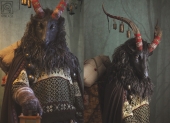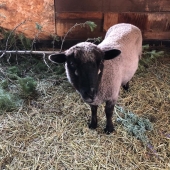Thanks for the grammatical tip. That's the first A(n) U--- explanation I've seen that actually makes sense to my brain. I'm severely dyslexic, but love the written word. It's not an awesome combination, but it makes for an interesting writing style... not to mention some creative interpretations by my spellchecker.
I have also finally acquired some fiber of my own--quite an enormous amount of it, by my lights--so now I can really dig into spinning. I am now the possessor of 2 pounds of Rosie's Blue-Faced Leicester top. It is undyed, since I have been wanting to make time to experiment with some wild-harvested plant dyes. According to the website, "[t]he preparation makes it easy to spin a smooth, lustrous yarn. This New Zealand BFL is a bit softer than our other Rosies BFL, though this is not as soft as domestic BFL as the breed was developed differently in New Zealand than in the US. There is minimal VM in this preparation and true to New Zealand BFL you will find some kemp fibers in the wool." Hopefully once I finish watching the Craftsy class and reading my next Alden Amos chapter, I will have a clue what all that means!
Sounds like lovely wool. 2 pounds is a nice amount to work with. Depending on the yarn you create and the size of the final object, you can get two to four adult sweaters from that, or a large blanket, or all sorts of other things. The description for the fibre is a bit jargon heavy for my liking. A lot of those terms and phrases are ones that most of my spinning friends don't understand. If you don't mind, I'll break it down for you.
Top: The wool has been scoured (washed at a specific temperature - or in large scale industrial settings, using specific chemicals - that break down the grease and allow the dirt to release more easily from the fibres) then the individual fibres are organized so that the majority of them are all facing the same way. There are a lot of different ways to organize the fibres before spinning them, this way encourages a smooth yarn with very little air trapped between the fibres. Many people prefer to spin this worsted style, however, it can also be spun woolen, or a combination draft if you like. It's entirely up to you. It may be fun to experiment with different styles of spinning to see which gives the result you like best - I know some books and people will say that this wool, prepared this way, MUST be spun that way. However, you know something they don't: it ain't their wool. It's YOUR wool, and You can spin it however you like. My suggestion is to experiment, observe, and learn - this will teach you the best way to spin that particular fibre. You may be surprised by the beautiful yarn you can make by spinning the 'wrong way'.
Blue Faced Leicester, is a breed of sheep which typically has a long, shiny wool, with minimal crimp (waviness). The breed standards are very strict, however each country has their own standards, and there is substantial divergence between North American, for example, and New Zealand lines.
Soft and Softer - these are very subjective, and the write up does not tell us how they mean. It could be that the individual fibres are finer, or the scales on the fibre are not as open, or... ?
VM - vegi matter, which is basically hay, weed seeds, thistles and such. Sheep are dirty creatures and they eat hay. Hay gets in their wool. Some wool farmers put coats on their sheep, but these fleeces to prevent this.
Kemp - This is a coarse hair that some sheep have. This is quite common in the old breeds (aka, pre 1700) which generally had three types of fibre. The outer coat, or longwool - which shed the rain. The undercoat or down which is a short, insulating, soft fibre near the skin. And the kemp which is very like a bristle. Kemp won't take dye well and is undesirable in a cloth that will be worn next to the skin. Kemp is also called hair - as in hair shirt (one historical interpretation of that phrase). Kemp is most often found near the hind quarters of the fleece and is often skirted (removed along with the dung) at the time of shearing. However, some sheep have kemp throughout their wool. It depends a lot on the individual sheep and can be moderated somewhat through nutritional management.
With the rise of the woolen mills, the sheep were breed to have more standard wool that worked with the machines better. So most modern sheep breeds will have only one coat with a smattering of kemp. Suffolk, for example, is a fairly consistent squishy wool, with all the fibres being relatively the same length. Icelandic, however, will have an over coat, under coat and kemp. The Fleece and Fiber Sourcebook, you mentioned, goes into this better.
To define some of the words I used:
Worsted - creates a smooth, hard wearing yarn. This draw prevents the twist from entering the drafting zone.
Woolen - creates a fluffy, soft yarn, with lots of air between the individual fibres which insulates better than worsted yarns. This draw allows the twist to enter the drafting zone, and pulls against the twist.
Some of these terms have been in common use for several thousand years, with a great many regional variations of use, meaning and pronunciation. The definitions given here are not gospel, but rather an introduction to the general themes of how these terms are used these days in North America.
For dying using wild harvest - I really enjoy Harvesting Color: How to Find Plants and Make Natural Dyes by Rebecca Burgess
I find this video by her also very inspiring:
Love your post and links. Here's an apple.

 3
3














 1
1




 1
1


















 1
1














 2
2














 1
1




 2
2














 1
1




 2
2

























 2
2

























 1
1











 1
1























